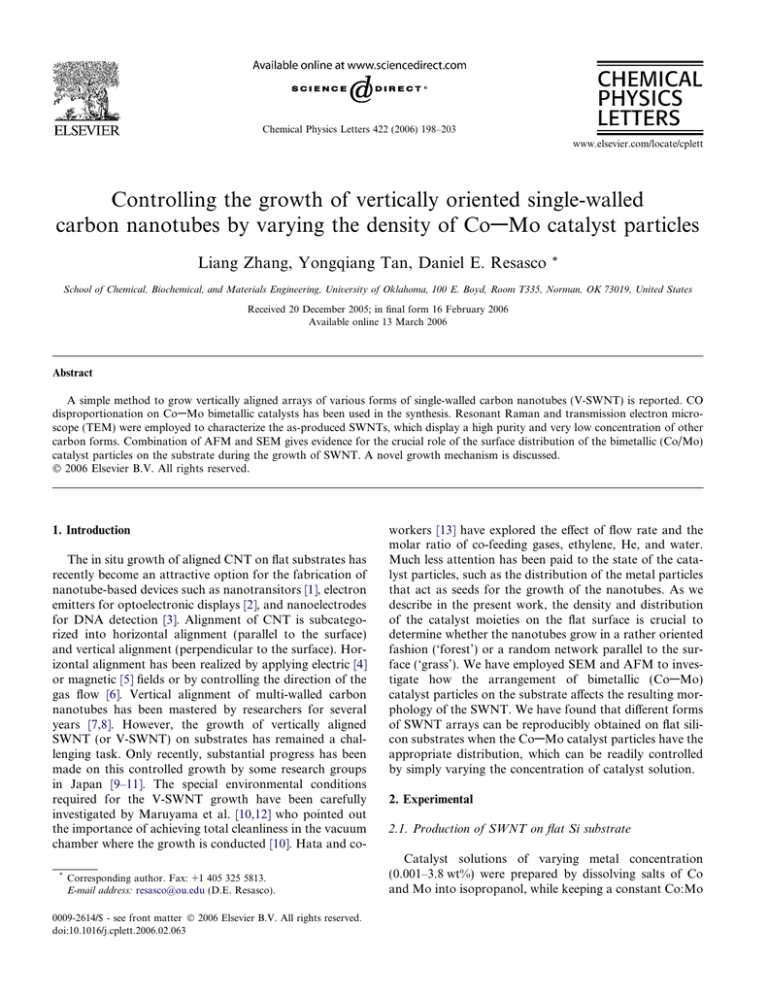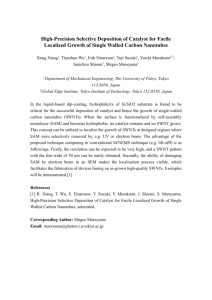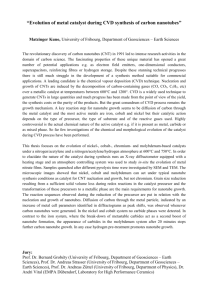
Chemical Physics Letters 422 (2006) 198–203
www.elsevier.com/locate/cplett
Controlling the growth of vertically oriented single-walled
carbon nanotubes by varying the density of CoAMo catalyst particles
Liang Zhang, Yongqiang Tan, Daniel E. Resasco
*
School of Chemical, Biochemical, and Materials Engineering, University of Oklahoma, 100 E. Boyd, Room T335, Norman, OK 73019, United States
Received 20 December 2005; in final form 16 February 2006
Available online 13 March 2006
Abstract
A simple method to grow vertically aligned arrays of various forms of single-walled carbon nanotubes (V-SWNT) is reported. CO
disproportionation on CoAMo bimetallic catalysts has been used in the synthesis. Resonant Raman and transmission electron microscope (TEM) were employed to characterize the as-produced SWNTs, which display a high purity and very low concentration of other
carbon forms. Combination of AFM and SEM gives evidence for the crucial role of the surface distribution of the bimetallic (Co/Mo)
catalyst particles on the substrate during the growth of SWNT. A novel growth mechanism is discussed.
Ó 2006 Elsevier B.V. All rights reserved.
1. Introduction
The in situ growth of aligned CNT on flat substrates has
recently become an attractive option for the fabrication of
nanotube-based devices such as nanotransitors [1], electron
emitters for optoelectronic displays [2], and nanoelectrodes
for DNA detection [3]. Alignment of CNT is subcategorized into horizontal alignment (parallel to the surface)
and vertical alignment (perpendicular to the surface). Horizontal alignment has been realized by applying electric [4]
or magnetic [5] fields or by controlling the direction of the
gas flow [6]. Vertical alignment of multi-walled carbon
nanotubes has been mastered by researchers for several
years [7,8]. However, the growth of vertically aligned
SWNT (or V-SWNT) on substrates has remained a challenging task. Only recently, substantial progress has been
made on this controlled growth by some research groups
in Japan [9–11]. The special environmental conditions
required for the V-SWNT growth have been carefully
investigated by Maruyama et al. [10,12] who pointed out
the importance of achieving total cleanliness in the vacuum
chamber where the growth is conducted [10]. Hata and co*
Corresponding author. Fax: +1 405 325 5813.
E-mail address: resasco@ou.edu (D.E. Resasco).
0009-2614/$ - see front matter Ó 2006 Elsevier B.V. All rights reserved.
doi:10.1016/j.cplett.2006.02.063
workers [13] have explored the effect of flow rate and the
molar ratio of co-feeding gases, ethylene, He, and water.
Much less attention has been paid to the state of the catalyst particles, such as the distribution of the metal particles
that act as seeds for the growth of the nanotubes. As we
describe in the present work, the density and distribution
of the catalyst moieties on the flat surface is crucial to
determine whether the nanotubes grow in a rather oriented
fashion (‘forest’) or a random network parallel to the surface (‘grass’). We have employed SEM and AFM to investigate how the arrangement of bimetallic (CoAMo)
catalyst particles on the substrate affects the resulting morphology of the SWNT. We have found that different forms
of SWNT arrays can be reproducibly obtained on flat silicon substrates when the CoAMo catalyst particles have the
appropriate distribution, which can be readily controlled
by simply varying the concentration of catalyst solution.
2. Experimental
2.1. Production of SWNT on flat Si substrate
Catalyst solutions of varying metal concentration
(0.001–3.8 wt%) were prepared by dissolving salts of Co
and Mo into isopropanol, while keeping a constant Co:Mo
L. Zhang et al. / Chemical Physics Letters 422 (2006) 198–203
molar ratio of 1:3. Subsequently, a drop of catalyst solution was deposited on a p-type Si wafer. After deposition,
the wafer was placed in a covered Petri dish to allow for
a slow drying that results in an uniform catalyst film. Following the drying step, the wafer containing the catalyst
film was baked in a convection oven at 100 °C for 10 min
and then at 500 °C for 15 min.
After pretreatment, the wafer was placed in a quartz
reactor, oriented parallel to the direction of the flowing
gas. Prior to the production of SWNT by CO disproportionation reaction, the catalyst was heated in H2 (500 °C),
and then in He (750 °C). Subsequently, a 1000 sccm flow
of pure CO was initiated at atmospheric pressure. In addition to uniform nanotube growth on uniform catalyst films,
patterned nanotube films were prepared by two different
methods, one in which the patterns occurred naturally
and the other in which we controlled the patterning. Natural patterns were formed when a wet catalyst thin film was
dried at a fast drying rate. This method resulted in separate
circular droplets of catalysts distributed over the Si substrate. By contrast, the controlled patterning was done by
using a mask and sputtering a film of AuAPd on a previously formed homogeneous catalyst film, prepared by slow
drying and calcined in air. In this way, the fraction of catalyst covered by the AuAPd alloy was selectively deacti-
199
vated and no nanotube growth occurred on those
regions. As a result, the nanotube forest only grew from
the remaining active catalyst. The as-produced SWNT
were characterized by Raman spectroscopy, electron
microscopy (SEM and TEM), and probe microscopy
(AFM).
3. Results and discussion
3.1. Influence of catalyst loading on the morphology of
SWNT formations
Fig. 1a–c illustrates the dramatic effect of catalyst loading on the resulting morphology of the SWNT formations.
This reproducible trend undoubtedly demonstrates that the
concentration of the catalyst solution affects the type of
SWNT growth on the Si substrate. The SEM images clearly
show that vertically aligned (V-SWNT forest) almost
40 lm in length were grown on the substrate impregnated
with catalyst solution of 0.19 wt% total metal (CoAMo)
concentration. By contrast, on wafers impregnated with
catalyst solutions of 0.38 wt% and 0.02 wt%, random
two-dimensional networks of SWNT (grass) were observed
after reaction. The sample with higher metal concentration
produced a higher nanotube density than the one with
Fig. 1. SEM images of SWNTs produced on silicon wafers with catalyst solution of different concentrations: (a) 0.38%, (b) 0.19%, and (c) 0.02%.
Concentration is in total metal weight.
200
L. Zhang et al. / Chemical Physics Letters 422 (2006) 198–203
lower metal concentration, but none of them resulted in
vertical growth. Apparently, there is an optimum surface
concentration of metals that results in vertical growth.
Besides, it was observed that grass grown with catalyst
solution of higher concentration was reasonably denser
than that with catalyst solution of lower concentration.
We have explored other concentrations both to higher
(up to 3.8 wt%) or lower (0.001 wt%) loadings, but none
of them produced V-SWNT forest. In fact, the very high
concentration resulted in the formation of carbon fibers
and multi-walled carbon nanotubes, while the lowest concentration of catalyst produced mostly scattered thin bundles of SWNT.
The structural characteristics of the nanotubes that make
up the forest and grass formations observed by SEM were
further evaluated by Raman spectroscopy and TEM. The
former is a well-known method for assessing the SWNT
quality based on the relative intensity of the D and G bands
[14,15]. The latter provides a direct identification of the nature of the carbon species deposited on the surface (i.e.,
SWNT, MWNT, amorphous, or nanofibers). Raman spectra (as shown in Fig. 2b) of the as-produced V-SWNT forest
were obtained with two excitation lasers (633 nm and
488 nm). The very low D/G ratio is consistent with SWNT
of high quality with a low concentration of defective nanotubes or disordered carbon species (e.g., nanofibers). At the
same time, it is well known that the frequency of the radial
breathing mode bands (RBM) is inversely proportional to
the nanotube diameter, according to the expression
xRBM = 234/dSWNT + 10 (cm 1)[16]. The spectra for the
V-SWNT sample obtained with the two different lasers
showed that the RBM brands cover a wide frequency range
(from 130 cm 1 to 300 cm 1), which corresponds to a diameter range 0.8–1.9 nm, a distribution much broader than
that typically obtained by the CoMoCAT method on
CoAMo catalysts supported on high-surface area silica
[17–19]. The broad distribution of diameters is also reflected
in the convergence of the G and G+ features and broad
base of the G band [13], in contrast with the sharper lines
and more pronounced separation of the G and G+ contributions for the G band in the CoMoCAT material [20]. The
TEM observations of the V-SWNT directly taken from the
substrate without any purification indicated the presence of
nanotubes of varying diameters (Fig. 2a) in agreement with
the Raman spectra (Fig. 2b). At the same time, TEM gives
ample evidence of the cleanness of the as-prepared VSWNT; in contrast with samples produced by any other
method, they appear free of metal impurities.
To explore the relationship between the metal loading
on the substrate and the resulting morphology of the
SWNT formations we employed atomic force microscopy
(AFM), a powerful tool that provides three-dimensional
profiles of surfaces. By investigating the morphology of
the catalyst surface before the growth of nanotubes, we
were able to identify the optimum distribution of particles
that result in V-SWNT forest. This analysis is illustrated in
Fig. 3 that contrasts high-magnification SEM pictures of
Fig. 2. Structural characterization of VSWNTs: (a) TEM images of
VSWNT material removed off the silicon wafer without any purification
and (b) Raman spectra of as-produced VSWNTs with excitation lasers of
wavelengths 633 nm (solid line) and 488 nm (dashed line).
the SWNT formations and AFM images of calcined catalyst/substrates for three different metal loadings. The
AFM image in panel a2 clearly shows that the catalyst particles generated from the impregnating solution with the
low metal concentration (0.02 wt%) were small and sparse.
From this metal distribution, a similarly sparse formation
of two-dimensional SWNT grass was obtained (panel a1).
In the case of intermediate metal concentration
(0.19 wt%), the AFM in panel b2 evidences a dense population of nano-particles with relatively uniform size. The
average distance between these particles was around 60–
70 nm. The SEM image (b1) shows that this distribution
is successful in promoting the formation of V-SWNT forest. Interestingly, the density of nanotubes bundles is
approximately the same as the density of catalyst particles
observed by AFM before the growth, which suggest that
essentially every catalyst particle is active for the production of nanotubes. By contrast, in the case of 0.38 wt%
metal concentration as shown in panel c2, some bigger
alloy particles formed on the surface and possibly generated larger cobalt clusters which are not suitable for SWNT
L. Zhang et al. / Chemical Physics Letters 422 (2006) 198–203
201
Fig. 3. Side-by-side comparison of SEM pictures (left column) of SWNTs with AFM images (right column) of corresponding silicon wafers with catalyst
solution of different concentrations: (a) 0.02 wt% , (b) 0.19 wt%, and (c) 0.38 wt%. Concentration (wt%) refers to total metal weight. AFM images were
obtained after the silicon wafers were calcined in oven at 500 °C. All the scale bars in SEM images are 500 nm and the widths of the AFM 3D squares are
1 lm except the one in panel a2, which is 5 lm.
nucleation, while a small fraction of Co clusters with the
optimum size to grow SWNT still remained between large
ones. Thus, a thicker layer of SWNT grass was grown as
shown in panel c1.
3.2. Discussion of growth mechanism of vertically oriented
SWNT
To explain the strong influence of the catalyst loading
on the resulting nanotube morphology we will analyze
the growth of nanotubes at three-levels, as illustrated in
Fig. 4. The first level of analysis is regarding the growth
of each individual SWNT. The TEM observations show
that the SWNT grow from the bottom, with the active
nano-clusters remaining on the substrate throughout the
reaction. As shown in molecular modeling simulations
[21,22], following the nucleation step, the nanotube cap
forms and is lifted from the cluster surface, leaving metal
sites open for a continuous incorporation of carbon atoms
via surface diffusion. The second-order structure to analyze
is the formation of bundles of individual tubes, held
together by van der Waals forces. Researchers have
debated whether an individual catalyst particle produces
an individual nanotube, which later bundles up with other
nanotubes, or the individual catalyst particle produces a
number of nanotubes bundled together from the root.
There have been observations that support each of the
two possibilities. For example, Gavillet and co-workers
[23,24] have reported convincing TEM images that show
bundles of SWNT growing from a common catalyst particle. At the same time, Li et al. [25] have reported equally
convincing images of individual SWNT produced by individual metal particles, whose size in turn determines the
nanotube diameter. We believe that either case is possible
to occur depending on the nature of the catalyst and the
reaction conditions.
On high surface area supports, which are able to stabilize extremely small metal particles, the one-particle-one-
202
L. Zhang et al. / Chemical Physics Letters 422 (2006) 198–203
Fig. 4. Schematic diagram illustrating the proposed growth mechanism of third-order structures of VSWNTs: from left to right is first-order structure of a
single tube, second-order structure of a bundle, and third-order structure, which can be 2D (xy) grass or 1D (z) forest.
nanotube structure may be prevalent. On bimetallic catalysts, which decompose under reaction conditions generating the active species in-situ, one single bimetallic aggregate
can decompose into several nucleation centers, thus giving
rise to more than one nanotube per particle. As we have
previously proposed for the CoAMo system,[26] after the
treatment in hydrogen the partially reduced cobalt molybdate readily transforms in the presence of CO into molybdenum carbide and cobalt nano-clusters. Experimental
results and theoretical calculations [27] have provided evidence to the hypothesis that the main function of molybdenum in CoAMo catalysts is to act as a matrix that
stabilizes the active cobalt nano-clusters. Based on this picture, one can envision the generation of a bundle of several
individual SWNT from a single CoAMo aggregate. The
SEM images in Figs. 1 and 3 suggest that individual VSWNT bundles originate from each of the alloy particles
on the substrate.
The third level of analysis addresses the formation of
either an ordered array of V-SWNT or a two-dimensional
random structure. As shown in this contribution, the average distance between alloy particles plays an import role
here. As shown in Fig. 3, the average distance that resulted
in the growth of V-SWNT was around 60–70 nm. When the
average distance is larger than that, as in the case of 0.02%
metal concentration, the SWNT bundles are not able to sustain their upward growth tendency and start bending
toward the surface in random direction. In the case of the
0.38% metal concentration, aggregated alloy particles seem
to generate large cobalt clusters and due to their non-optimum size lose their ability to template the carbon nucleation for the SWNT growth. Therefore, it is possible that
those large clusters become quickly deactivated and as
shown in Fig. 3c render part of the surface inactive and
make the actual average distance between active particles
larger than that necessary for V-SWNT growth.
An important observation needs to be further discussed.
When the carbon deposits of a V-SWNT are observed
directly perpendicular to the surface, a random network
of SWNT bundles is clearly evident over the top of the forest, while the observation at different angles clearly shows
the well-aligned structure shown in Fig. 1b. There is no
doubt that, in this case, the root-growth mechanism is
operative. Therefore, the nanotube fraction that is
observed on top of the forest has been formed during the
first stages of reaction, while the ordered growth only
occurs later, seemingly constrained by the presence of the
two-dimensional crust formed in the initial stages. Initially,
a layer of randomly arranged SWNT grows from a loose
network to a dense network. The density of this network
depends on the surface concentration of the catalyst. With
a low concentration of catalyst only a rather loose structure
is formed. By contrast, in a region with the proper catalyst
density a dense nanotube array forms a crust that constitutes a rather rigid structure. This crust is later lifted up
by the growing nanotubes from the bottom (see Fig. 1b).
This is the reason why, while each individual nanotube is
not perfectly straight and not necessarily every nanotube
has the same length, the overall forest has a smooth top
surface.
To further demonstrate the effect of the distribution of
catalyst particles on the growth of SWNT on flat surfaces,
CoAMo catalysts were patterned over the Si wafer by the
two methods described in the experimental section, a natural patterning and a manual patterning. In the case of the
natural pattern, fast drying in the air resulted in microscopic circular areas with varying concentration of catalyst.
For the manual process, a TEM grid was used as a mask to
protect the previously deposited CoAMo catalyst. The
fraction of the surface that was not covered by the grid
was deactivated by a film of Au/Pd sputtered over the surface. The resulting patterned growth of V-SWNT obtained
by the two methods is illustrated in Fig. 5. Image (a1)
shows volcano-shaped SWNT arrays on the substrate patterned by the fast drying method. A cross-sectional image
of one of these volcanoes in higher magnification (a2)
shows that they comprise vertically aligned SWNT near
the edge of the ring, with two-dimensional random
arrangements in the middle part. Image (a2) shows parallel
V-SWNT bars grown on the active catalyst area defined by
the TEM grid. Due to diffusion of AuAPd from the edge
into the space between grid and surface, there is a catalyst
L. Zhang et al. / Chemical Physics Letters 422 (2006) 198–203
203
Fig. 5. SEM images of orderly arrays of SWNTs patterned by fast drying process (a) and grid-masked sputter coating (b). Images were taken with lower
(1) and higher magnification (2).
concentration gradient in the edge area. As a result, the forest in this area bends towards the outside with the crust on
the top extending continuously to the grass attached to the
substrate.
Acknowledgements
We gratefully acknowledge the financial support from
Department of Energy (Grant DE-FG03-02ER15345)
and from the National Science Foundation (Grant No.
CTS-0308619). We also thank Bill Chissol and Preston
Larson for their help with SEM measurements.
References
[1] W.B. Choi, J.U. Chu, K.S. Jeong, E.J. Bae, J.W. Lee, J.J. Kim, J.O.
Lee, Appl. Phys. Lett. 79 (2001) 3696.
[2] L.M. Dai, Smart Mater. Struct. 11 (2002) 645.
[3] J. Li, H.T. Ng, A. Cassell, W. Fan, H. Chen, Q. Ye, J. Koehne, J.
Han, M. Meyyappan, NanoLetters 3 (2003) 597.
[4] Y.G. Zhang, A.L. Chang, J. Cao, Q. Wang, W. Kim, Y.M. Li, N.
Morris, E. Yenilmez, J. Kong, H.J. Dai, Appl. Phys. Lett. 79 (2001)
3155.
[5] J.E. Fischer, W. Zhou, J. Vavro, M.C. Llaguno, C. Guthy, R.
Haggenmueller, M.J. Casavant, D.E. Walters, R.E. Smalley, J. Appl.
Phys. 93 (2003) 2157.
[6] S.M. Huang, M. Woodson, R. Smalley, J. Liu, NanoLetters 4 (2004)
1025.
[7] Y.C. Choi, Y.M. Shin, Y.H. Lee, B.S. Lee, G.S. Park, W.B. Choi,
N.S. Lee, J.M. Kim, Appl. Phys. Lett. 76 (2000) 2367.
[8] C.J. Lee, D.W. Kim, T.J. Lee, Y.C. Choi, Y.S. Park, Y.H. Lee, W.B.
Choi, N.S. Lee, G.S. Park, J.M. Kim, Chem. Phys. Lett. 312 (1999)
461.
[9] G.F. Zhong, T. Iwasaki, K. Honda, Y. Furukawa, I. Ohdomari, H.
Kawarada, Chem. Vapor Depos. 11 (2005) 127.
[10] S. Maruyama, E. Einarsson, Y. Murakami, T. Edamura, Chem. Phys.
Lett. 403 (2005) 320.
[11] K. Hata, D.N. Futaba, K. Mizuno, T. Namai, M. Yumura, S. Iijima,
Science 306 (2004) 1362.
[12] Y. Murakami, E. Einarsson, T. Edamura, S. Maruyama, Carbon 43
(2005) 2664.
[13] D.N. Futaba, K. Hata, T. Yamada, K. Mizuno, M. Yumura, S.
Iijima, Phys. Rev. Lett. 95 (2005) 056104.
[14] F. Tuinstra, J.L. Koenig, J. Chem. Phys. 53 (1970) 1126.
[15] M.S. Dresselhaus, P.C. Eklund, Adv. Phys. 49 (2000) 705.
[16] A. Jorio, M.A. Pimenta, A.G. Souza, R. Saito, G. Dresselhaus, M.S.
Dresselhaus, New J. Phys. 5 (2003) 139.
[17] S.M. Bachilo, L. Balzano, J.E. Herrera, F. Pompeo, D.E. Resasco,
R.B. Weisman, J. Am. Chem. Soc. 125 (2003) 11186.
[18] D.E. Resasco, L. Balzano, J.E. Herrera, O. Matarredona, L. Zhang,
Am. Inst. Phys. Conf. Proc. 723 (2004) 27.
[19] F. Hennrich, R. Krupke, S. Lebedkin, K. Arnold, R. Fischer, D.E.
Resasco, M.M. Kappes, J. Phys. Chem. B 109 (2005) 10567.
[20] F. Buffa, H. Hu, D.E. Resasco, Macromolecules 38 (2005) 8258.
[21] F. Ding, K. Bolton, A. Rosen, J. Phys. Chem. B 108 (2004) 17369.
[22] F. Ding, A. Rosen, K. Bolton, Carbon 43 (2005) 2215.
[23] J. Gavillet, J. Thibault, O. Stephan, H. Amara, A. Loiseau, C.
Bichara, J.P. Gaspard, F. Ducastelle, J. Nanosci. Nanotech. 4 (2004)
346.
[24] J. Gavillet, A. Loiseau, C. Journet, F. Willaime, F. Ducastelle, J.C.
Charlier, Phys. Rev. Lett. 87 (2001) 275504.
[25] Y.M. Li, W. Kim, Y.G. Zhang, M. Rolandi, D.W. Wang, H.J. Dai, J.
Phys. Chem. B 105 (2001) 11424.
[26] J.E. Herrera, L. Balzano, A. Borgna, W.E. Alvarez, D.E. Resasco, J.
Catal. 204 (2001) 129.
[27] (a) J. Zhao, A. Martinez-Limia, P.B. Balbuena, Nanotechnology 16
(2005) S575;
(b) P.B. Balbuena, J. Zhao, S. Huang, Y. Wang, N. Sakulchaicharoen, D.E. Resasco, J. Nanosci. Nanotech. (in press).






